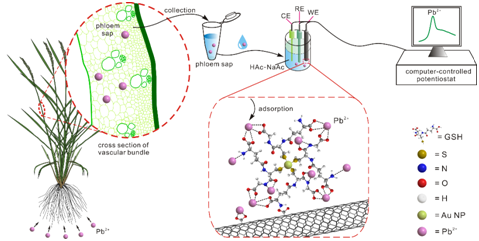Heavy metal ions (HMIs) in rice pose a threat to human health through the human food chain. Monitoring of HMIs in rice phloem sap is of great significance for studying the migration and the accumulation of HMIs in rice plants. However, achieving sensitive and selective electroanalysis of HMIs in such complex real samples is a huge challenge due to the severe interference.
In a paper published in Environmental Science-Nano, the research group led by Prof. HUANG Xingjiu in the Institute of Intelligent Machines, Hefei Institutes of Physical Science, and Prof. Wu Yuejin in the Institute of Technical Biology, Hefei Institute of Physical Science, developed a useful simple sensor for selective electrochemical detection of heavy metal ions (HMIs) in complex rice phloem sap.
The team fabricated a sensitive and anti-interference sensing interface based on the glutathione-functionalized gold/multi-walled carbon nanotubes (MWCNTs-GSH-Au-GSH) for the analysis of Pb2+ in rice phloem sap.
Combining the selective capturing ability of glutathione and the electrocatalytic ability of gold nanoparticles toward Pb2+, the sensitivity of the MWCNTs-GSH-Au-GSH is up to 1122.8 μA μM-1 cm-2 without interference of other small ions, sucrose, ATP, amino acids, plant hormones, and so on. The limit of detection (0.01 μM) can meet the requirement of sensing trace Pb2+.
Especially, MWCNTs-GSH-Au-GSH electrode exhibits a excellent stability in the 6-month test. In addition, the developed sensor shows a high reproducibility that is verified by ten different MWCNTs-GSH-Au-GSH electrodes.
Based on the above advantages, MWCNTs-GSH-Au-GSH electrode can be well applied to detection of Pb2+ in rice phloem sap.
The mechanism for high selectivity and sensitivity of MWCNTs-GSH-Au-GSH electrode toward Pb2+ is clearly investigated by X-ray photoelectron spectroscopy (XPS) and extended X-ray absorption fine structure (EXAFS). XPS results show that Pb2+ is strongly captured by –COOH, –CONH– and –NH2 on MWCNTs-GSH-Au-GSH, and EXAFS further proves these strong interactions.
This achievement provides a simple and effective method for monitoring HMIs in the roots, stems, leaves and fruits of rice plants and for further studying the migration and transformation of HMIs in rice plants.
The name of the paper: Selective capture of Pb2+ in rice phloem sap using glutathione-functionalized gold nanoparticles/multi-walled carbon nanotubes: enhancing anti-interference electrochemical detection

Schematic diagram of the electrochemical sensor for detection of Pb2+ in rice phloem sap. (Image provided by JIANG Min) Keywords: MWCNTs-GSH-Au-GSH; Pb2+; Rice phloem sap; Electrochemistry
Contact:
Prof. HUANG Xingjiu, Ph. D
Institute of Intelligent Machines, Chinese Academy of Sciences, Hefei 230031, China
Tel: 86-551-6559-1167
Email: xingjiuhuang@iim.ac.cn
